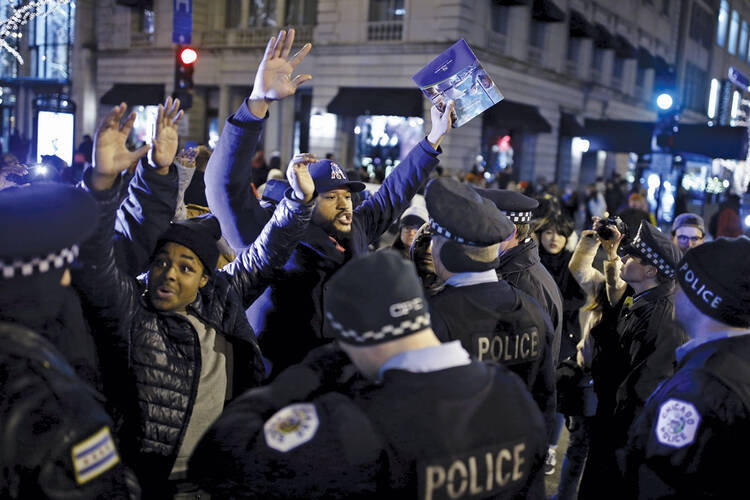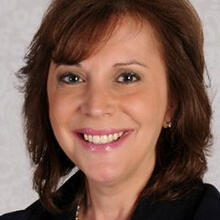As the world properly focuses its attention on the recent carnage in San Bernardino, Paris and elsewhere and concerns grow over whether terrorists will soon strike again, a different kind of terror continues to afflict people in the United States. It is the daily violence on U.S. streets, often involving the nation’s youth and, regrettably, sometimes its police.
In the nation’s heartland, the city of Chicago offers a troubling profile in violence that is becoming familiar in other cities as well. More than 2,800 people were shot in Chicago last year, and by December 2015 there had been 417 gun homicides, up almost 20 percent from the previous year.
Chicago’s suffering became vividly clear to the nation with the release on Nov. 24 of a police video of an incident captured in October 2014. It showed a uniformed officer repeatedly firing at the teenager Laquan McDonald, even as he lay wounded in the street. Large protests followed the release of the video, and Chicago’s Mayor Rahm Emanuel quickly fired the police superintendent, Garry McCarthy. A federal probe into police procedures in Chicago has been initiated as calls for the mayor’s resignation grow louder.
Even before the McDonald controversy, the city had been reeling from the execution-style murder of 9-year-old Tyshawn Lee. A fourth-grader who dreamed of playing in the N.B.A., Tyshawn was lured from a basketball court into an alley and shot at close range in the head and back. His presumed offense: he was the son of a reputed gang member.
Just a few weeks before Tyshawn’s murder, an 11-month-old baby was shot while being held in his mother’s arms. His mother and grandmother were gunned down. Only the baby survived.
Tyshawn Lee’s suspected killer is alleged to have been seeking revenge for the shooting deaths of his own mother and brother. According to prosecutors, the 27-year-old Terror Dome gang member reportedly vowed to kill “grandmas, mamas, kids and all” in his South Side Auburn Gresham neighborhood.
“We’re a city of walking wounded families,” said the community activist and crisis responder Dawn Valenti.
South-Side Peacemaking
Leo Tolstoy, surveying the chaos and suffering of 19th-century Moscow, asked, “What then can be done?” It is a question our churches and communities need to be asking. Fortunately, there are many in Chicago who have taken up the challenge to bring hope and healing.
Ms. Valenti is part of a crisis team called Chicago Survivors. The group includes many mothers who have lost children to violence, mothers like Toneya McIntosh, whose teenage son was killed.
“It’s a struggle every day for me and my family to wake up knowing I can’t see him no more, can’t hear his voice, see that beautiful smile,” Ms. McIntosh says.
Or like Diana Aguilar, whose 6-year-old daughter, Aliyah, died in a drive-by shooting.
“You’re nervous, you’re scared, you don’t know what to do,” Ms. Aguilar says about the aftermath of a shooting.
Chicago Survivors’ corps of volunteers arranges counseling for victims’ families, organizes funerals and candlelight vigils, helps families navigate the police investigative process and sends “Peacemaker” speakers into the schools. In one recent case, Ms. Valenti even arranged for professional cleaners to remove the blood stains from a family’s car, where two young men died in a gang-related ambush.
Susan Johnson, an American Baptist minister, heads Chicago Survivors. Ms. Johnson was pastor at a church not far from where the Obamas have a home in Chicago’s Hyde Park-Kenwood neighborhood. She decries what she calls “the normalcy we’ve ascribed to seeing a murder a day.”
Lingering spiritual questions are often the hardest to address in gun violence cases. Ms. Johnson says family members are angry, frequently at God. About 75 percent of those families have small children still in the home. They often experience subsequent panic attacks. Early and repeated exposure to violence can affect their ability to learn and to interact with others.
“It’s very difficult to stay by the side of a survivor. Their path to recovery is a long one,” Ms. Johnson says.
Support from local churches and pastors is essential, but often missing, she adds. “Very few walk the anti-violence walk.”
Looking for Alternatives
David Kelly, a Precious Blood priest, is one of those who are trying to walk that walk. Father Kelly is a leader in a movement called Restorative Justice. His work as a chaplain at the Cook County Juvenile Detention Center led him to conclude that putting kids in jail fuels crime instead of preventing it.
Restorative justice focuses less on punishing crime than on seeing how those who have perpetrated a wrong can make it right. It calls for building a greater sense of community in troubled neighborhoods and for creating dialogue between warring groups.
“We’re not just nice people doing nice things,” Father Kelly says. “Restorative justice looks at the issue of who was harmed, who did the harm and how we can repair the harm. It deals with relationships, because ultimately, crime is a violation of relationship.”
It is also a way, he says, of holding kids accountable “without labeling them demons or criminals.” And, he adds, it is gaining support among a growing number of judges who hear juvenile cases.
The United States continues to incarcerate more youths than any other country in the industrialized world—an estimated 70,800 juveniles in 2010. That is more than the population of several U.S. state capitals.
While youth violence remains an intractable problem, an overwhelming majority of incarcerated young people have been jailed for nonviolent offenses, and African-American youth are nearly five times as likely to be confined as their white peers. “No Place for Kids,” a report by the Annie E. Casey Foundation in 2011, found that juveniles who spend time in detention have higher rates of recidivism than those placed in alternative programs, are less likely to return to school and are less likely to find jobs.
Then there is the cost of incarceration. It takes an estimated $66,000 to $88,000 to house a young person in a correctional facility for nine to 12 months—far more than it costs to attend some public universities for a year.
But there is also reason for hope. The number of juveniles in detention has dropped by about 30,000 from a 1995 high of 107,600. That is due in part to efforts to seek new, innovative responses to delinquency that are more humane and cost-effective, especially for non-violent and first-time offenders.
The veteran Cook County Juvenile Court judge Colleen Sheehan is one of those looking for alternatives. Ms. Sheehan supports a proposal to form restorative justice community courts for offenders 18- to 24-years-old. Offenders in that age group, she says, currently have fewer alternative options than juveniles have.
“We’re coming to a point in time when [courts] have to do something different, new and innovative,” Ms. Sheehan says, “or we’re going to become irrelevant.”
The judge has sent some of her juvenile offenders to gatherings called Peace Circles, organized by Father Kelly and held with offenders, victims and their families. In these meetings, each side can freely express emotions and come to some sort of resolution.
Peace Circles for conflict resolution have their roots in both Quaker and Native American spirituality. At one recent circle, a teenager had to face a young father whose home he had burglarized.
“Little by little, people spoke, not to the issue of the burglary, but of themselves,” Father Kelly recalls. “People began to lean in and engage one another in a more intimate way.” The burglary victim and the teenager who robbed him learned they had much in common. Both had absentee fathers and overworked mothers who struggled to provide for them.
The man whose home was burglarized said what disturbed him the most was not that a window was broken and some of his possessions stolen but that his 5-year-old son said to him afterward, “Daddy, I don’t want to live here any more.”
“What he had vowed as a father, to protect his son and give him a home that was safe, was taken from him in the burglary,” Father Kelly said.
The Peace Circle ended with the young father saying what he wanted as restitution: for the young boy to return to school and check in with him periodically on his progress.
Like Susan Johnson of Chicago Survivors, Father Kelly says churches have been largely missing in action in the struggle against youth violence. “The churches need to open their doors. They need to make kids feel welcome,” he says. “Instead, churches are afraid of these kids. They need to go out, find these kids and build relationships so they can feel they belong.”
Archbishop Blase Cupich of Chicago has urged the U.S. Conference of Catholic Bishops to make gun control and curbing gun violence one of the church’s top priorities in the 2016 presidential election. The archbishop recently told the Chicago Federation of Labor, “I want the church to become an even more committed partner...joining with business, government and labor in promoting the lives and dignity of those who are too often left behind in our city, nation and the world.”
A Short Life, Destined for Tragedy
Of course, a few isolated programs alone cannot solve the problem. The Rev. Michael Pfleger, a longtime Chicago activist, says there has been a consistent lack of will on the part of government, business and churches to address the root causes of urban violence in neighborhoods.
“We’ve got to confront our failed education systems and the lack of options and opportunities,” Father Pfleger said at Tyshawn Lee’s funeral. “We’ve got to look at the broken bridge between law enforcement and the community...to confront the gun lobby and the NRA [National Rifle Association] who is running to the bank while blood runs in our streets.”
A recent report on the Cook County juvenile justice system sponsored by Roosevelt University and Adler University in Chicago found that putting teenagers into the penal system disrupts their connection to school, particularly their ability to receive special education services. The report also said incarceration adds to mental health issues, raises the risk of suicide and increases their acceptance of criminal thinking.
Furthermore, the study notes, “participants identified the paradox of not being able to receive any preventative services for themselves and/or their children without first becoming involved with the [criminal] justice system.”
The death of Laquan McDonald, the young man whose shooting was captured on that now-infamous police video, did not occur in a vacuum. It came at the end of a short life that seemed destined for tragedy. At the age of 3, Mr. McDonald was taken by the Department of Children and Family Services from a mother who neglected him. He was returned home, but at the age of 5, was removed again after his mother’s boyfriend beat him.
Mr. McDonald was sent to another foster home before a grandmother took him in and gave him some semblance of stability. She died when he was 15. Less than a year later, he was picked up on his first charge—possession of marijuana. He had been attending an alternative school for 16- to 21-year-olds and seemed to be doing better. But on the night of his death, according to police, traces of P.C.P. were found in his body.
What if Tyshawn Lee’s murderer had been offered the chance to be part of one of Father Kelly’s Peace Circles long before the Terror Dome gang took hold of his life? What if there were enough safe havens for Laquan McDonald? Would he have turned to a life of petty crime and drugs before dying in a hail of bullets?
It may sound naïve to propose inviting police and angry community leaders or police officers and suspects into peace-making circles. But is it any crazier than what is happening on Chicago’s streets?
What then can be done, indeed.








